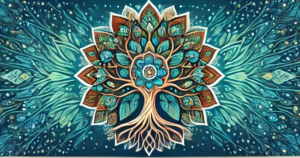The Trickster Archetype in Shamanism and Mythology
Many cultures all over the globe have prominent depictions of the Trickster archetype. In shamanism and mythology alike, the Trickster has been a multifaceted and intricate figure, from the Norse deity Loki to the Native American Coyote. We’ll look at the Trickster’s aim and purpose in this discussion, as well as how it can transform your life and open your eyes to new potential.
“The trickster is a boundary crosser, a shape-shifter. He is both subhuman and superhuman, a being of the margins, the ultimate outsider.”
– Lewis Hyde
What is the Trickster archetype?
The Trickster is an archetypal figure that appears in many mythologies and cultures. He frequently takes the form of a cunning, mischievous person who challenges the established order. In shamanism, the Trickster is a potent entity that can effect transformation and change. Although the Trickster archetype is frequently linked to chaos and unpredictability, it also catalyzes ingenuity and innovation.
The Trickster can appear in a variety of shapes, including gods and deities, animals, and people. Though there are entities that embody the trickster archetype fully, the trickster archetype can be temporarily expressed by any of your guides or guardians – or even your highest consciousness – when circumstances warrant.
“The trickster is a figure who crosses borders, who turns things upside down. He is a figure of transformation and change.”
– Michael Meade
Trickster Archetypes in Mythology
The trickster character in Norse folklore is called Loki. He is frequently depicted as a shape-shifter and troublemaker who delights in wreaking havoc and starting fights.
Native American Mythology: In many Native American mythologies, such as those of the Navajo, Hopi, and Crow peoples, Coyote is a trickster character. He is renowned for both his ingenuity and deception skills as well as his capacity to invent and put new things into existence.
African folklore: The trickster Anansi the Spider appears in West African folklore. He is renowned for his intellect and cunning, frequently using these traits to outwit opponents and achieve his goals.
Hindu Mythology: In Hindu mythology, Krishna is occasionally viewed as a trickster character. He is renowned for his lighthearted demeanor and tactical brilliance when engaged in combat. This ability to outsmart his opponent lends to his reputation as the occasional trickster.
Japanese folklore features the trickster character Inari. She can change into different forms and is frequently depicted as a mischievous fox who loves to pull pranks on people.
Celtic Mythology: In Irish mythology, the Leprechaun is a trickster character. He is renowned for being cheeky and having the power to fulfill wishes, but he is also known for having little patience and a fondness for gold.
Hermes is a sly character from Greek mythology. He is renowned for his shrewdness and capacity for trickery, as well as for his work as a gods’ emissary and a protector of travelers.
Tezcatlipoca is a trickster figure from Aztec mythology. He is renowned for his capacity to transform into various shapes and influence people while frequently abusing his abilities for his own self-serving ends.
Australian Aboriginal Mythology: A common trickster character in Australian Aboriginal mythologies is the Rainbow Serpent. It is a strong spirit noted for being unpredictable and is connected to both creation and destruction.
In Inuit folklore, the raven is a representation of a trickster. He is renowned for his shrewdness and his capacity to change into various shapes, frequently using these abilities to outwit his adversaries.
Baba Yaga is a trickster character from Slavic folklore. She resides in a hut that is supported by chicken legs and is a strong witch. Baba Yaga is renowned for her unpredictability and her power to either benefit or hurt those who come into contact with her.
Chinese Mythology: The Monkey King, also referred to as Sun Wukong, is a trickster character. He is renowned for being naughty and having the ability to change into various shapes, frequently using these traits to outwit his foes.
“The trickster is a master of disguise, a jester who takes delight in upsetting the status quo.”
– Malidoma Patrice Somé
The Purpose and Goal of the Trickster
In shamanism, the Trickster’s role is to upend the established order and bring about change. The Trickster is a catalyst for change who frequently upsets the status quo to introduce fresh viewpoints and ways of being. The Trickster can be thought of as a catalyst for development and evolution, driving people and communities to advance and adjust to changing conditions.
The Trickster’s objective is metamorphosis and change, but doing so frequently has a price.
The Trickster has the potential to be a destructive power, leaving a wake of chaos and upheaval. As old methods of being are questioned and replaced with new ones, this destruction can also result in new development and evolution.
Consider the world since 2020. All has indeed been upended; chaos and unpredictability has become the new norm. Perhaps, following the maxim “as above, so below,” the prevalence of coyotes in our urban areas to the degree that they’re considered an infestation and scourge by the general populace might have foreshadowed this current upheaval.
The state of the world since 2020 has been presented to me as “spring cleaning.” When we deep clean, there’s a stage of the process that often looks like complete destruction, where closets and drawers are upended and everything is out. This stage, though daunting, allows us to really see all that we have hidden away in the deep recesses so that we can sort through to determine what needs to stay, go, or be reordered. This is the classic work of the Trickster.
“The trickster is the mythological equivalent of the court jester, the one who speaks truth to power, who makes the king laugh and yet holds the power to undermine his authority.”
– Joseph Campbell
The Trickster in Your Life
The Trickster archetype can be a strong influence in your life, encouraging you to question the status quo and effect change. You can question the established order and gain new perspectives with the aid of the Trickster. You can unlock your own creativity and innovation by adopting the Trickster archetype, which will enable you to make good changes in your life.
But it’s crucial to keep in mind that the Trickster can also be a destructive power, leaving a wake of disarray and upheaval. There is some measure of risk and difficulty associated with embracing the Trickster archetype; therefore it’s important to proceed with an awareness and understanding of the role the Tricker is playing.
We, in our society, place a great deal of value on creation. We do not tend to regard destructive processes with the same degree of appreciation. This is unfortunate because the processes are yin and yang to one another. We cannot create – not well anyway – without a prior stage that allows us to destroy what is no longer needed or beneficial. We must have a process that recycles old worn-out energies and creates space for us to birth the new.
We know that upheaval and chaos tend to send us into fearful states of mind. Therefore, if the Trickster creates so much upheaval and chaos, how can we embrace him without devolving into fear? This is the most important aspect of working with the Trickster archetype – and make no mistake, you rarely have a choice in working with him. That means it’s very important to understand this point; to work effectively with Trickster, you must be willing to release fear and lean into states of surrender and trust.
“The trickster is the archetype of the paradox, the unexplainable, the two-sided, the ambiguous, the ambivalent.”
– Lewis Hyde
An Expanded View of the Trickster Archetype
There’s a deeper aspect of the Trickster that’s very prominent right now. Though we typically see the Trickster operating through chaos and destruction, this isn’t always the case. Sometimes, continuous pressure doesn’t get the job done. If something is really “stuck,” it can be helpful, and more gentle, to use a push/pull or oscillation technique. This type of redirection is a technique I use in my practice when I encounter mental resistance or deeply lodged energies.
If you’ve ever tried to push a car out of the mud, you know that it’s very difficult to just push continually in the forward direction. It’s often more productive to push, release, allow the car the rock back (while you get a quick break), then push again. Creating momentum through rocking is a very effective technique whether we’re talking about a stuck car, stuck mental paradigms, or stuck energy in the body.
Since the Trickster is often working directly on our thought forms (mental beliefs), occasionally he’ll present through an alternate mechanism. He may trigger a fearful or anxious belief and then, if you’re unable to work through the fear or anxiety, he’ll release the pressure for a moment. This is the cycling that many of us experience. Traditionally, we consider this as a sign of being “stuck.” And though it is, it doesn’t mean we’re “frozen;” often we’re subtly building the momentum that will propel us through our transformation.
Another variation – if we’re in a particularly challenging circumstance, trickster archetypal energy might come in not to trigger us, but to pull us out of fearful places we aren’t in a position to tackle.
For example, if I’m particularly anxious about something, and that something is unavoidably outside of my control, my guides and guardians might choose to “falsely” reassure me, enabling me to continue moving forward and do the things I need to do. This looks (and feels) a great deal like false promises, even lying (particularly if things go badly, from our human viewpoint), but it’s the Trickster’s attempt to “salvage” a very delicate situation. During my Ayahuasca ceremony, I noticed this particular manifestation of the Trickster archetype many times. The goal of the ceremony was to surrender and release, so if I started down a path of resistance, they’d quickly shift gears to keep me “comfortable.”
Conclusion
In shamanism and mythology, the Trickster archetype is a potent force that can symbolize a source of invention and creativity as well as a force for chaos and destruction. You can challenge the status quo, bring about change, and develop by accepting the Trickster in your life. The Trickster should, however, be approached with caution, and it’s essential to be conscious of the potential risks and difficulties that come with embracing this archetype. The Trickster can be a strong ally, but whether or not you choose to accept its call to change and transformation is entirely up to you.
References
- Levi-Strauss, Claude. (1966). The Savage Mind. University Of Chicago Press. Retrieved from https://www.press.uchicago.edu/ucp/books/book/chicago/S/bo3630151.html
- Hyers, Conrad. (1996). The Comic Vision and the Christian Faith: A Celebration of Life and Laughter. Oregon State University Press. Retrieved from https://osupress.oregonstate.edu/book/comic-vision-and-christian-faith
- Jung, C. G. (1959). Archetypes and the Collective Unconscious. Princeton University Press. Retrieved from https://press.princeton.edu/books/paperback/9780691018331/archetypes-and-the-collective-unconscious
- Radin, Paul. (1955). The Trickster: A Study in American Indian Mythology. Schocken Books. Retrieved from https://www.penguinrandomhouse.com/books/60797/the-trickster-by-paul-radin/
- Hyde, L. (2008). Trickster Makes This World: Mischief, Myth, and Art. Macmillan.
- Meade, M. (2006). The World Behind the World: Living at the Ends of Time. Greenfire Press.
- Somé, M. P. (2010). The Healing Wisdom of Africa: Finding Life Purpose Through Nature, Ritual, and Community. Penguin.
- Campbell, Joseph. The Hero with a Thousand Faces. Princeton University Press, 2008.
Schedule a Session With Me
If you’d like to go deeper in a supportive, healing environment, please visit my scheduling page.




